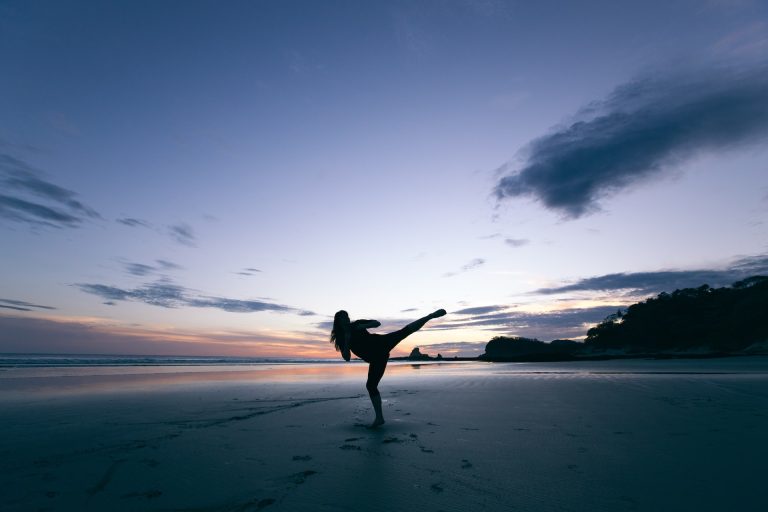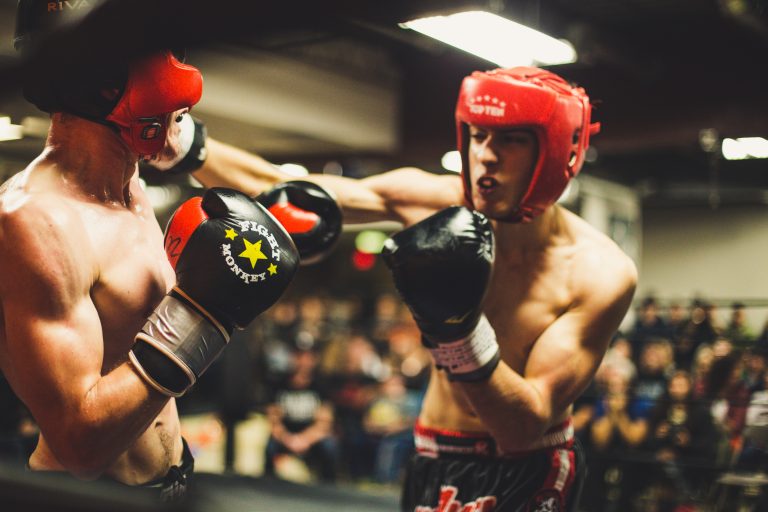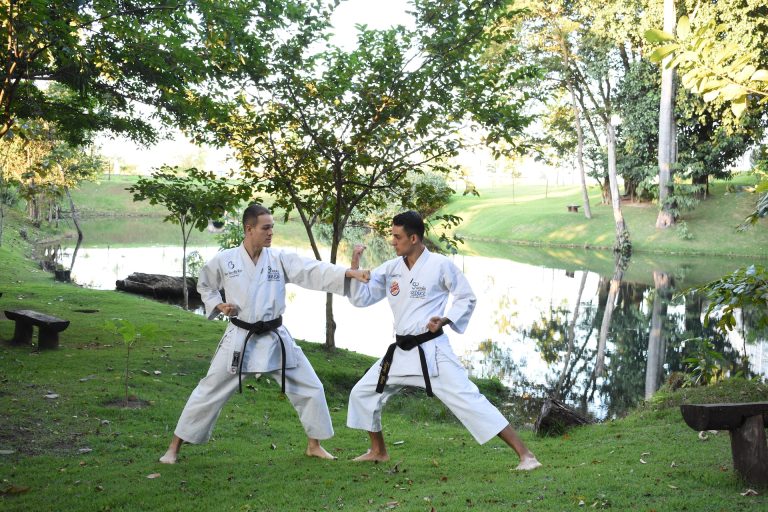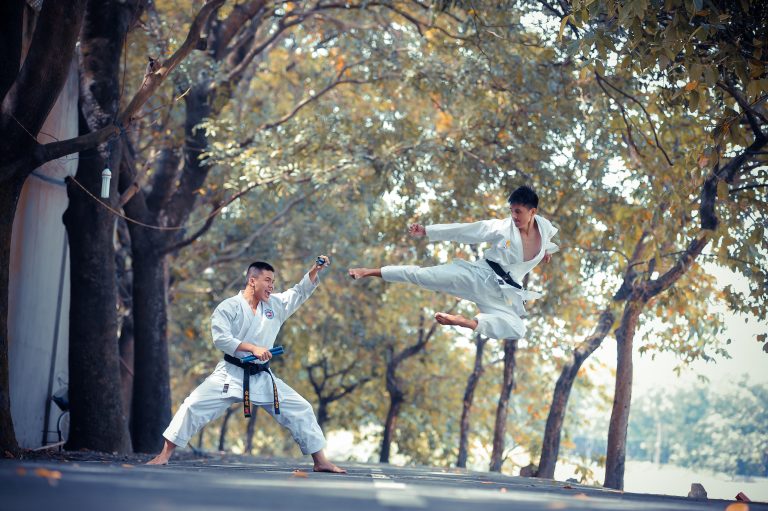Arten von Karate-Kicks und -Stößen
Karate ist eine Kampfkunst, die in vielen Teilen der Welt praktiziert wird. Eine der Hauptkomponenten von Karate sind die Kicks und Stöße. In diesem Beitrag werden wir uns die verschiedenen Arten von Karate-Kicks und -Stößen ansehen.
Arten von Karate-Kicks
1. Mawashi-Geri: Dies ist ein Rundkick, bei dem du deinen Fuß in einer kreisförmigen Bewegung in die Luft hebst und deinen Gegner beim Zurückschwingen triffst. Es ist eine sehr effektive Technik, die oft als KO-Kick verwendet wird.
2. Yoko-Geri: Dies ist ein seitlicher Kick, bei dem du deinen Fuß seitlich in die Luft hebst und deinen Gegner mit der äußeren Kante deines Fußes triffst. Es ist ein schneller und präziser Kick, der häufig zur Abwehr von Angriffen eingesetzt wird.
3. Mae-Geri: Dies ist ein Frontkick, bei dem du deinen Fuß nach vorne hebst und deinen Gegner mit deiner Schienbeinspitze triffst. Es ist eine sehr mächtige Technik, die oft zur Abwehr von Angriffen verwendet wird.
4. Ushiro-Geri: Dies ist ein Rückwärtskick, bei dem du deinen Fuß nach hinten hebst und deinen Gegner mit der Ferse treffer. Es ist eine sehr effektive Technik, die oft als Überraschungsangriff verwendet wird.
5. Kin Geri: Dies ist ein Schienbeintritt, bei dem du deinen Fuß mit der Schienbeinspitze in den Körper deines Gegners triffst. Es ist eine sehr mächtige Technik, die oft zur Abwehr von Angriffen verwendet wird.
Arten von Karate-Stößen
1. Gyaku-Zuki: Dies ist ein gerader Fauststoß, bei dem du deine Faust direkt auf den Körper deines Gegners schlägst. Es ist ein schneller und kraftvoller Schlag und kann sowohl zur Abwehr als auch zum Angriff eingesetzt werden.
2. Oi-Zuki: Dies ist ein Fauststoß mit Schritt nach vorne, bei dem du deinen Fuß vor dem Schlag nach vorne bringst und gleichzeitig deine Faust in den Körper deines Gegners schlägst. Es ist ein sehr kraftvoller Angriff, der oft zur Abwehr von Angriffen eingesetzt wird.
3. Tate-Zuki: Dies ist ein vertikaler Fauststoß, bei dem du deine Faust von unten nach oben schlägst. Es ist eine sehr ungewöhnliche Technik, die oft zur Überraschung deines Gegners verwendet wird.
4. Ura-Zuki: Dies ist ein hinterer Fauststoß, bei dem du deine Faust von hinten in den Körper deines Gegners schlägst. Es ist ein sehr effektiver und überraschender Angriff, der selten erwartet wird.
5. Kagi-Zuki: Dies ist ein Hakenstoß, bei dem du deine Faust in einem gebogenen Bogen schlägst. Es ist ein sehr starker und präziser Schlag, der oft zur Abwehr von Angriffen verwendet wird.
In der Karate-Praxis werden diese Techniken ständig trainiert und sind ein wesentlicher Bestandteil des Kampfes. Es ist wichtig, dass Karateka sich über die verschiedenen Arten von Kicks und Stößen informieren, damit sie im Kampf effektiv agieren und sich verteidigen können.
Fazit
Karate ist eine Kampfkunst, die verschiedene Techniken verwendet, darunter Kicks und Stöße. In diesem Beitrag haben wir uns die verschiedenen Arten von Karate-Kicks und -Stößen angesehen, die in der Kampfkunst eingesetzt werden. Indem wir diese Techniken verstehen und trainieren, können wir uns im Falle eines Angriffs effektiv verteidigen und auch erfolgreich angreifen.
Frequently Asked Questions About Types of Karate Kicks and Strikes
Karate is a popular form of martial arts that originated in Okinawa, Japan. It involves a variety of techniques, including kicks, punches, blocks, and strikes. Kicking and striking are key components of karate, and it is important to understand the different types of kicks and strikes to become a well-rounded karateka. In this blog post, we will answer some of the most frequently asked questions about types of karate kicks and strikes.
1. What are the types of karate kicks?
Karate kicks are classified based on the part of the body used to deliver the kick. The following are some of the most common types of karate kicks:
a. Mae Geri (Front Kick)
Mae geri, also known as the front kick, is a straight kick delivered with the ball of the foot or the heel. This kick is used to strike an opponent’s midsection, groin or face.
b. Yoko Geri (Side Kick)
Yoko geri, also known as the sidekick, is delivered by bringing the knee up and extending the leg out to the side. This kick is aimed at the body’s midsection, ribs, or face.
c. Mawashi Geri (Roundhouse Kick)
Mawashi geri, also known as the roundhouse kick, is a powerful and effective kick. It involves a circular motion of the leg, aiming at the ribs, head or the side of the body.
d. Ushiro Geri (Back Kick)
Ushiro geri, known as the backkick, is a kick delivered with the heel of the foot. This kick involves turning your body 180 degrees and kicking backward.
e. Jodan Kekomi (Front Thrust Kick)
Jodan kekomi, commonly known as the front thrust kick, is a powerful kick directed at the opponent’s face or head area. This kick uses the ball of the foot.
f. Tobi Geri (Flying Kick)
Tobi geri, known as the flying kick, is a fancy and impressive kick used in some forms of karate. It involves jumping towards your opponent while delivering a kick.
2. What are the types of karate strikes?
Karate strikes are classified based on the part of the body used to deliver the strike. Some common types of karate strikes are:
a. Shuto Uchi (Knife-Hand Strike)
Shuto uchi, also known as the knife-hand strike, is delivered using the edge of the hand. It is used to attack vulnerable areas such as the neck or the throat.
b. Haito Uchi (Ridge-Hand Strike)
Haito uchi, also known as the ridge-hand strike, is a powerful and effective strike delivered with the side of the hand or the knuckles.
c. Tettsui Uchi (Hammerfist Strike)
Tettsui uchi, known as the hammerfist strike, is delivered using the fleshy part of the hand. This strike is often used to attack an opponent’s vital areas like the temple or the nose.
d. Uraken Uchi (Back-Fist Strike)
Uraken uchi, also known as the back-fist strike, is a fast and effective strike delivered with the back of the fist. This strike targets the chin or the temple.
e. Empi Uchi (Elbow Strike)
Empi uchi, known as the elbow strike, is a powerful strike delivered with the elbow joint. This strike is usually aimed at the head or the ribs.
3. What is the difference between a kick and a strike in karate?
Kicks and strikes are different techniques used in karate. Kicks involve using the legs to strike an opponent, while strikes involve using the hands or other parts of the body to attack. Kicks are generally used to attack an opponent from a distance, while strikes are used in close-range combat.
4. How to improve karate kicks and strikes?
Improving karate kicks and strikes requires a lot of practice and dedication. Here are some tips on how to improve your techniques:
- Practice kicking and striking with proper form and technique
- Stretch regularly to improve flexibility
- Strengthen your legs and arms through strength training exercises
- Focus on improving your speed and power
- Train with a partner to practice hitting a moving target
5. Is it necessary to wear shoes while practicing karate kicks and strikes?
It is not necessary to wear shoes while practicing karate kicks and strikes. In fact, most practitioners prefer to practice barefoot as it allows them to feel the ground and maintain balance. However, some karate schools may require students to wear particular karate shoes for hygiene or safety reasons.
Conclusion
Karate kicks and strikes are essential techniques used in self-defense and sparring. Understanding the different types of kicks and strikes is crucial in becoming an effective and well-rounded karateka. By practicing these techniques regularly and with proper form, you can improve your overall technique, speed, and power.
Inhaltsverzeichnis






